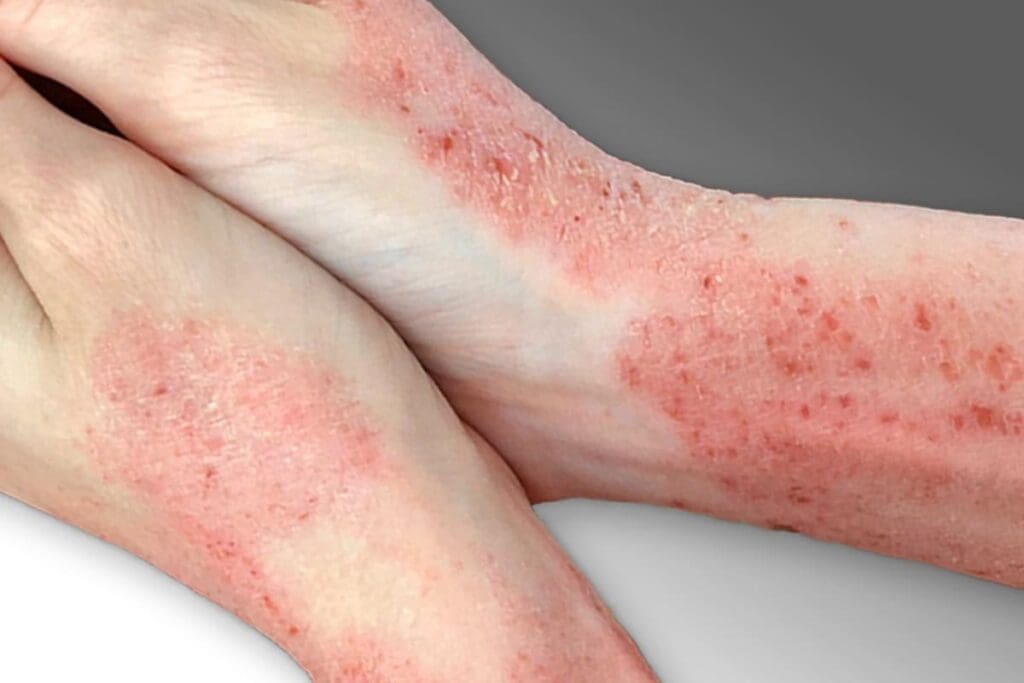Beef fat, or tallow, is giving new hope to eczema sufferers!
Chances are good that we all know of someone who battles with eczema, that awful inflammatory skin irritation that flares up and leaves us itchy, raw, and scrambling to find something that will soothe the constant discomfort. In fact, eczema is becoming such a common condition that over 31 million people have been diagnosed with it nationwide1, with numbers growing larger every day. Sadly, many over-the-counter lotions and eczema treatments are lacking in the fundamental building blocks that our skin needs to help calm and rebuild it from the inside out.
Thankfully, there is natural relief ahead for eczema sufferers, and it all starts with tallow!
What exactly is eczema?
Eczema is a clinical grouping of inflammatory skin conditions2 that are characterized by dry, scaly patches of skin, severe itchiness, and even blisters. Eczema can easily be confused with psoriasis, another inflammatory skin condition, so it’s important to consult a medical professional if you begin experiencing symptoms. They can help you get an accurate diagnosis and set your feet on the right path to managing your discomfort.
There are several different categories of eczema that a person might experience, namely, atopic dermatitis, contact dermatitis, dyshidrotic eczema, nummular eczema, seborrheic dermatitis and stasis dermatitis.
Atopic dermatitis is, by far, the most common type of eczema3, with its foremost symptom being dry, itchy patches of skin that spread out from the original site. Typically, children as young as 6 months old4—in some cases, younger— can being to experience discomfort from atopic eczema, and it can be difficult to know which products will be gentle enough to protect their well-being, yet potent enough to help soothe that delicate skin. Conversely, it is very possible for adults to experience sudden-onset flare-ups as well, even if they have never struggled with skin inflammation before5.

What causes eczema?
It is difficult to pinpoint a singular cause of this skin condition, but it is widely understood that when the body comes into contact with an irritant, either internal or environmental, one of the possible responses to that irritant is an internal inflammatory response that, in turn, can cause eczema to pop up6.
Genetics, an over-active immune system, environmental allergies, nutritional deficiencies, etc. are all possible underlying causes for eczema sufferers7. People who struggle with chronic eczema often will have triggers that are associated with their itchy flare-ups, and each person’s “ON” switch will vary.
Some of the most common triggers are:
- Environmental irritants
- Food allergies
- Harsh soaps and skincare products
- Artificial fragrance and dyes
- Dry skin
- Stress
- Nutritional deficiencies
- Compromised immune system
- Lack of beneficial gut bacteria
- Hormonal changes
Management of these triggers is one of the best ways to prevent flare-ups and avoid unnecessary discomfort before it even begins.
What do I do when I have eczema on my skin?
The first thing to do is: don’t itch. This is so difficult to manage, particularly for young children who don’t have the self-control or understanding to resist tearing away at that skin that hurts. Eczema patches are scaly, delicate, and prone to tearing at the least provocation, and itching will open up the skin to unwanted bacteria. Apply a skin protectant at the first sign of a flare-up to create a barrier between the lesion and the things around it.
Keep the area free of sweat and soap. Using only a damp cloth, gently dab the area to ensure that sweat and dirt are not in contact. Your first inclination may be to cleanse it. But soaps, even natural ones, contain surfactants that will strip the skin of its remaining moisture. If your hands are ground zero for you, try using gloves when using dish soap or products with skin-stripping ingredients.
Stay away from creams and lotions with alcohol in them. Sadly, even products with the words “eczema relief” on them will not soothe your eczema if the product contains alcohol. If you’ve ever used them on broken skin yourself, you know this to be true! Over-the-counter creams may help temporarily, but most likely you will be left with a painful burning sensation that just adds more discomfort, and the scaly patches will remain.
Avoid your triggers. Easier said than done, admittedly! However, if an ounce of prevention is worth a pound of cure, then the management of your own personal catalysts is worth its weight in gold.
So the big question becomes…what can I use to help my eczema?

Can beef fat really help my eczema?
The answer is YES! Grass-fed beef tallow is an extraordinary, albeit relatively under-utilized substance that has everything you need to help soothe and repair itchy skin caused by eczema. It is extremely gentle on even the most fragile of skin, and is safe to use as often as needed.
Tallow contains naturally-occurring vitamins and acids that work together to penetrate deep down through the layers of your skin to deliver relief…fast! While most lotions and creams sit on the surface layer of your skin and take a long time to absorb (leaving you feeling greasy), tallow is uniquely composed to mimic your skin’s own natural sebum, or oil8. This makes it incredibly effective as it soaks into your skin, and it is one of the big reasons why grass-fed tallow for skin care is really starting to make waves in the skincare marketplace.
Vitamins A, D, E, and K are abundantly found in the tallow of grass-fed cows, particularly in the leaf fat of the animal. These building blocks not only fight the inflammation9 caused by the immune response to eczema triggers, but they also begin to build back your skin at the cellular level. No chemicals, no lab-created compounds, no artificial vitamins – NO BURNING!
This can truly be a blessing for those of you seeking eczema relief for small children, since products that utilize leaf tallow from grass-fed beef are exceptional at treating eczema in people of all ages, especially children who have more sensitive skin.

How do I use tallow to soothe my eczema?
Simply massage a small amount of a tallow-based product into the affected area as soon as symptoms arise, reapplying as often as needed. The result is calmed skin, less itch, and a protective barrier that’s comfortable to function with while your skin repairs itself.
Where can I find products with grass-fed beef tallow in them?
Our family of products was initially created with eczema-sufferers in mind! All of our Whipped Tallow Balm products contain 4 or less ingredients, with local, grass-fed, 100% non-GMO tallow as it’s number 1 ingredient.
We pair our twice-purified tallow with organic, cold-pressed jojoba oil and all-natural essential oils that work together to calm and repair broken skin caused by eczema. Its light, whipped texture makes it absorb easily into the skin, so it’s not greasy and won’t stain fabrics or sheets.

If you are searching for that missing element in your skincare arsenal that delivers deep moisture to repair, calm, and rebuild your skin from the inside out, our family of Whipped Tallow Balms are just what you need!
- Eczema Can Affect Us All – WebMD ↩︎
- What is Eczema – National Eczema Association ↩︎
- What is Atopic Dermatitis – National Eczema Association ↩︎
- How Age Effects Eczema – VeryWell Health ↩︎
- Can You Get Eczema as an Adult? – American Academy of Dermatology ↩︎
- What Causes Eczema – Cleveland Clinic ↩︎
- Eczema Causes and Triggers – National Eczema Association ↩︎
- Tallow for Healthy Skin – tuttofare.com ↩︎
- How To Use Tallow for Eczema – atopicdermatitis.net ↩︎














